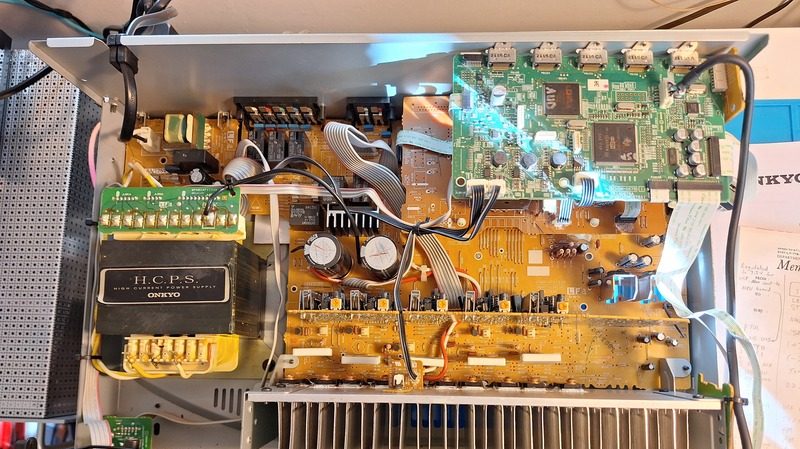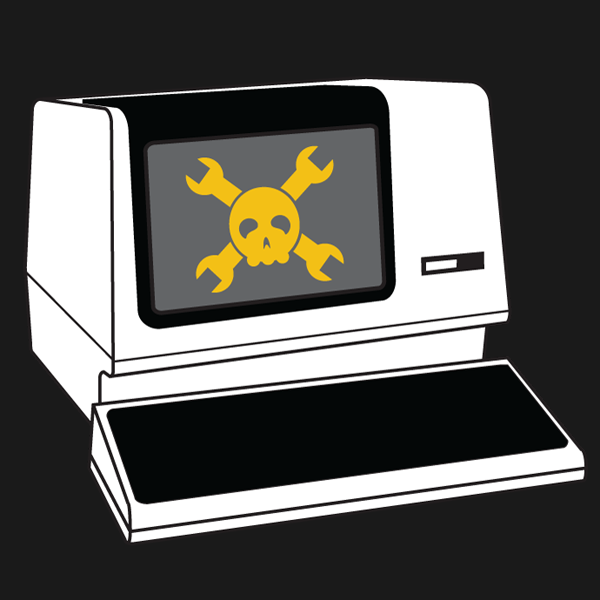[Bill Dudley] had a problem. He had an Onkyo AV receiver that did a great job… until it didn’t. A DSP inside failed. When that happened, the main microprocessor running the show decided it wouldn’t play ball without the DSP operational. [Bill] knew the bulk of the audio hardware was still good, it was just the brains that were faulty. Thus started a 4-month operation to resurrect the Onkyo receiver with new intelligence instead.
[Bill’s] concept was simple. Yank the dead DSP, and the useless microprocessor as well. In their place, an ESP32 would be tasked with running things. [Bill] no longer cared if the receiver had DSP abilities or even the ability to pass video—he just wanted to use it as the quality audio receiver that it was.
His project report steps through all the hard work he went through to get things operational again. He had to teach the ESP32 to talk to the front panel display, the keys, and the radio tuner. More challenging was the core audio processor—the obscure Renaisys R2A15218FP. However, by persevering, [Bill] was able to get everything up and running, and even added some new functionality—including Internet radio and Bluetooth streaming.
It’s a heck of a build, and [Bill] ended up with an even more functional audio receiver at the end of it all. Bravo, we say. We love to see older audio gear brought back to life, particularly in creative ways. Meanwhile, if you’ve found your own way to save a piece of vintage audio hardware, don’t hesitate to let us know!
















Speaking of vintage, has anyone come up with a replacement for Kenwood 100W amplifier TA100 modules they can confirm working?
For the love of god, I hope someone comes backs with good news on this… I need one and can’t find them ANYWHERE other than by buying and gutting another amp, which would be pointless since I can just USE the good amp, but that still leaves me with a dead one :,(
There seem to be substitute replacement modules you can get easily enough. Won’t those do?
Had someone bring an Onkyo receiver in for recycling as a few channels didn’t work. It was practically brand new – so after ensuring he really didn’t want it, I popped the serial into their service site and it was under warranty! A few weeks later I had a brand new receiver. If it goes flaky in the future this hack is a good place to start for information.
Did he have access to a schematic?
No, he reverse engineered it mostly by finding sister chips that had similar data sheets. Even if he did, it would have been pages long. Those recievers have a ton of PCBs piped together. I’ve had the displeasure of reviving one only to eventually give up on the DSP chip as they’re known to overheat and desolder themselves or short out. This is great stuff for anyone with one of these dying boxes. The company has been in financial struggle for years and last I remember they were bought out. But they made great receivers for the value, packing tons of features and even providing free upgrades via firmware updates. Alas, people just want soundbars now so you either have a crappy bar system or an expensive home theater, middle of the road is dead.
There seems to be a small market though:
https://reclaimedaudio.com.au/
I know where I’ll be browsing when one of my components releases its magic smoke.
Unfortunately this is common with almost all AVR’s today, just look on ebay a crapton of cheap Denon Yamaha, onkoyo. They still turn on and power off due to some fault, or turn on but no sound etc. It’s just cheap quality with a high priced name.
It’s true and I feel that that specific board is deliberately placed in such a way that it suffers the most heat abuse. Many are boxes completely with the av input boards and some even have a mounting point for a fan but neglected to install one. I feel that pioneer is one of the worst offenders between the cheap steel zink fins to an entirely boxed oven for control dsp
It’s pretty easy to find official schematics for onkyo receivers online; there’s absolutely no reason to believe the OP was working without one. I’ve got both the service manual and schematic for my SR576, and the schematic itself is only 10 pages long.
My vintage 1970’s Yamaha CR receiver’s operating manual has a schematic already supplied.
If i remember correctly, there was another onkyo unit that refused to work with a non working dsp chip, also by Texas Instruments. The DSP ran Wind River Linux and due to a design error the dsp would be faulty from manufacturing causing the Unit with enough heat and cool cycles to start acting weird or not working at all.
Yes, you are correct. The issue is down to TI’s DSPs that in their first generation started to fail after enough heat cool cycles.
Sometimes, reflowing the DSP would fix it for some time.
most likely, as elektrotanya has an 89 pages service manual….
I’m fairly sure that’s meant to be Renesas. :)
I remember years ago the Onkyos had a plague of bad SMD capacitors on the HDMI switching board (the top green PCB in the title picture). There is even a leaked confidential service bulletin about it.
I replaced those caps in my brother’s unit and it’s still working more than a decade later.
Happened to me also, twice, even after cap replacement. Ingenious design, putting the heat sensitive components at the top of the case. Obviously, the “analog” engineers don’t work well with the digital engineers, unless they are farming the digital part out entirely and then throwing it in the box. Never again with this company.
I was given an Onkyo receiver with the same issue. It is still sitting in the pile of devices “broken but too good to bin”.
In light of this guy’s work I might have a look at it again…. one day.
How did Renesas get to be Renaisys?
At the end of the article he’s nice enough to provide a bunchj of the details he found during the project written up for others to do the same job. That kind of thing is invaluable and over the years Ive found that they often disappear after a few short years.
I saw that it wasn’t listed on the internet archive so I submitted it to the wayback machine to be saved.
I wish there were more sites like that. It seems like relying on one entity is fairly risky. Some insane attack on the publishing it does that takes it down would be like a modern day burning of the Library at Alexandria.
Regarding the issue of trying to read the keypad and getting bad readings, I’d suggest that instead of just averaging the 16 readings, first throw out the highest and lowest values, then average the rest. I suppose looking for the mode average is really what you want, assuming you first bucket the values into expected ranges.
I suppose he could also get HDMI working by using a combination of a cheap HDMI switch and an HDMI audio extractor (or a combo device), assuming that hacking into the existing HDMI circuit is too much of a pain. Then there’s the alternative adventurous route of creating a replacement for the defective DSP. I enjoy being surprised at people’s ingenuity at getting into what seem like black boxes and figuring things out.
Now THIS is a proper Hackaday story about an actual hack!
Nice work. I love saving otherwise good, old equipment from the scrap heap.